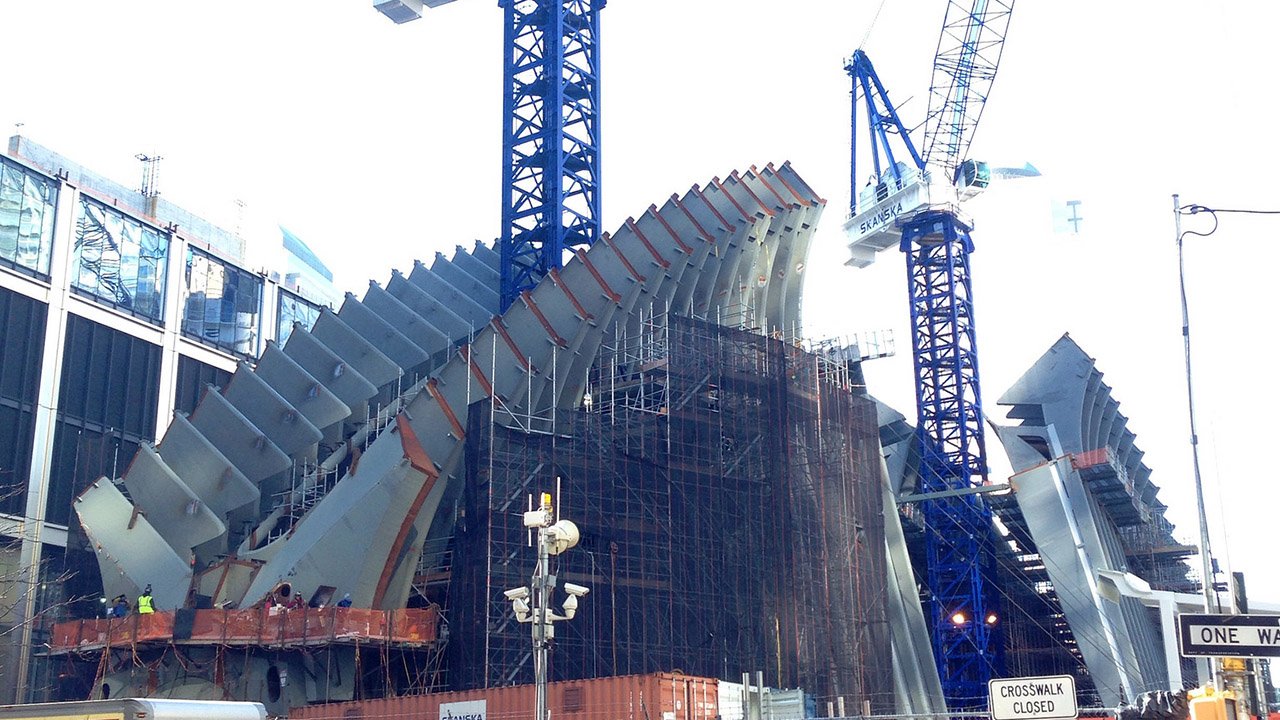City construction projects are notorious for exceeding budgets and timelines, but the World Trade Center Transportation Hub has bottomed even the lowest expectations, becoming “one of the most expensive and most delayed train stations ever built” in the city, reports the New York Times. The project, conceived in 2004 with a budget of $2 billion, has run past its original completion date of 2009, another deadline in 2011, and is now slated for completion in 2015, costing nearly twice the original estimate.
How did that happen? As one might suspect, what follows is a tale of gross mismanagement, grandiose visions, political agendas, and lots of ego. After examining “two dozen interviews and a review of hundreds of pages of documents,” the Times concluded this:
But whatever its ultimate renown, the hub has been a money-chewing project plagued by problems far beyond an exotic and expensive design by its exacting architect, Santiago Calatrava, according to an examination based on two dozen interviews and a review of hundreds of pages of documents. The soaring price tag has also been fueled by the demands of powerful politicians whose priorities outweighed worries about the bottom line, as well as the Port Authority’s questionable management and oversight of private contractors.
While the report is sure to infuriate taxpayers, the The Times’s analysis also serves an instructive “how not to” guide for any aspiring city planner or designer. Every step of the way, it seems, someone made a wrong move, delayed a decision, or turned a blind eye towards a problem that only got bigger and more expensive.
The project was doomed from the start, it seems:
“The original schedules and budgets were unrealistic to begin with,” the Port Authority conceded in a 2008 self-critique. “Had the rebuilding program gone without a hitch, those dates and costs could never have been met.”
The architect’s vision for the structure, called the Oculus, wasn’t financially viable:
Mr. Calatrava — known for lyrically expressive structures that are challenging and costly to build — insisted on column-free interiors, labor-intensive building methods and sculptural and curvilinear steel elements that could only practicably be manufactured abroad.
One factory in northern Italy produced one-third of the 36,500 tons of steel in the hub. The steel bill for the entire project was $474 million.
But officials were slow to realize this:
Mr. Calatrava’s boldest gesture called for a roof that could open to the sky. In 2005, not yet convinced that the roof was practical to build, authority officials including David Steiner, a board member, visited the Milwaukee Art Museum to see Mr. Calatrava’s operable roof there.
As they waited outside the museum, the officials were joined by schoolchildren who had also come to watch. When the screen opened, the children applauded. Mr. Steiner turned to Mr. Calatrava and, according to the recollection of those who were there, said: “O.K., Santiago. You can have your goddamn wings.”
It would take another three years to kill this exorbitant idea.
It didn’t help that then-governor George Pataki had his own personal agenda for the project:
George E. Pataki, a Republican who was then the governor of New York, was considering a run for president and knew his reputation would be burnished by a train terminal he said would claim a “rightful place among New York City’s most inspiring architectural icons.” He likened the transportation hub to Grand Central and promised — unrealistically — that it would be operating in 2009.
But the governor fully supported the Metropolitan Transportation Authority’s desire to keep the newly rebuilt No. 1 subway line running through the trade center site, instead of allowing the Port Authority to temporarily close part of the line and shave months and hundreds of millions of dollars off the hub’s construction. That, however, would have cut an important transit link and angered commuters from Staten Island, a Republican stronghold, who use the No. 1 line after getting off the ferry.
The authority was forced to build under, around and over the subway line, at a cost of at least $355 million.
As did Former Mayor Michael Bloomberg:
Michael R. Bloomberg, who was then the mayor, demanded in 2008 that the memorial be completed by the attack’s 10-year anniversary. That meant part of the hub’s roof, which would be the decking under the memorial plaza, had to be built first, adding about $75 million to the budget.
And the Port Authority did itself no favors, either:
A 2005 construction contract was supposed to set a guaranteed maximum price, but to accelerate the work, several expensive subcontracts were approved. And in 2008, the authority rejected money-saving suggestions worth over $500 million.
On top of all of that, though it’s built for a capacity of “160,000 PATH riders daily,” the hub’s foot traffic is less than a quarter than that of Grand Central Station’s. When all is said and done, the project “could turn out to be more of a high-priced mall than a transportation nexus, attracting more shoppers than commuters.” Unbelievable. Read the full, jaw-dropping report at the Times.
(Photo: Dear Edward)



